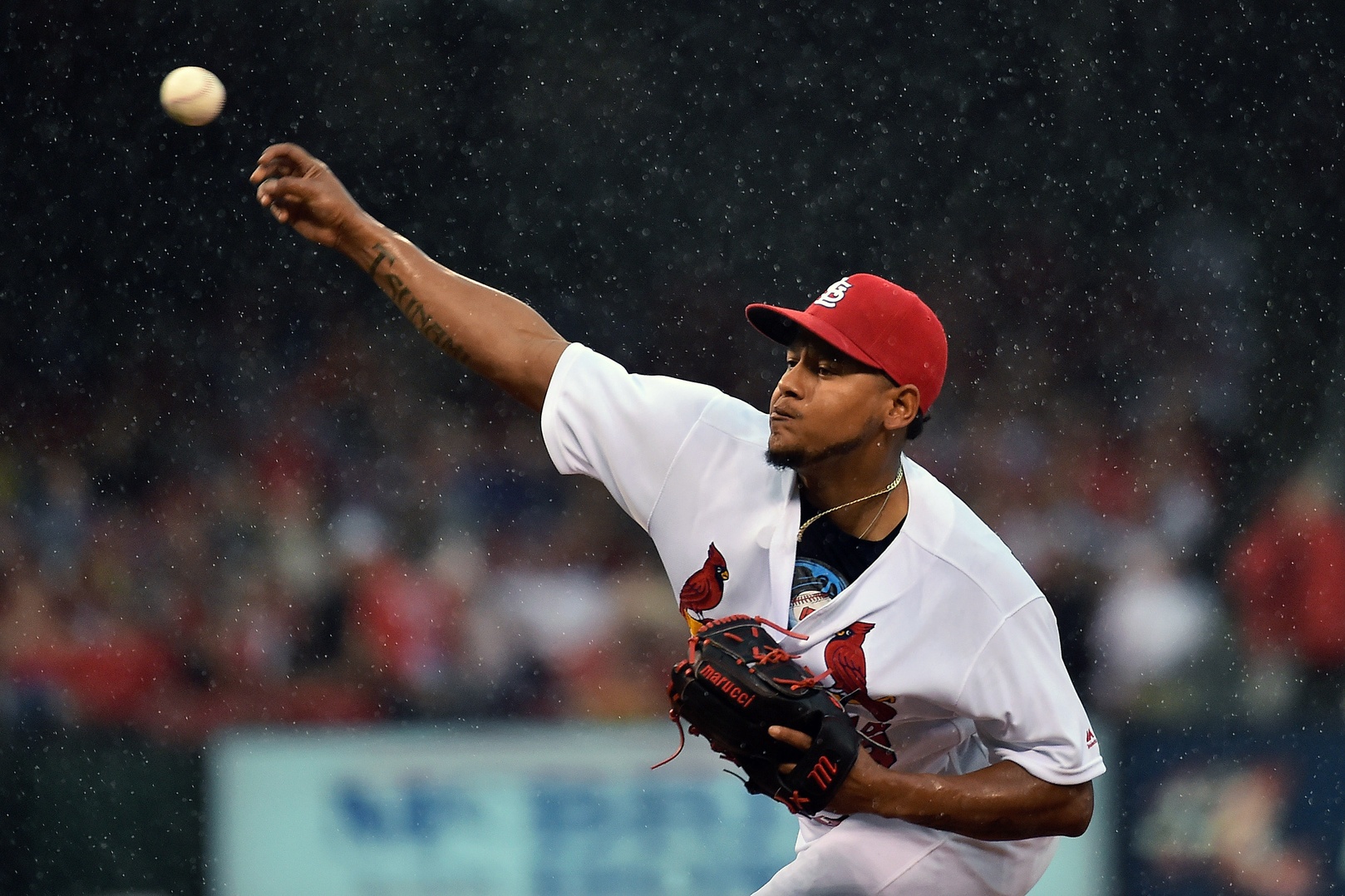A long rain delay and a teaser of an eighth-inning rally couldn’t undo the damage of a rocky start for Kyle Hendricks and an offense that had their getaway day shoes on.
Top Play: In the Cardinals’ half of the first inning, after a Stephen Piscotty grounder that eluded Tommy La Stella at third base and turned into a double, Matt Holliday was due next, and on a 1-0 pitch, Kyle Hendricks left a pitch aimed for the inside corner a little too far over the inner third of the plate. Holliday got around and under the ball, lofting a fly ball toward the left-field corner. It looked a bit like a mishit off the bat, but Holliday had connected well, launching the ball at 102 miles per hour. The blimp blaster kept carrying, until all Kris Bryant (a left fielder, today) could do was watch it land in the third row. Only three home runs hit this season have had a steeper launch angle off the bat than Holliday’s 40 degrees: one each by Marcus Semien, Brandon Belt, and Jose Bautista. This one looked like a Bautista special, but there’s no penalty for mimicry in baseball. The 362-foot homer (+0.164) put the Cardinals in front for good.
Bottom Play: Because Win Probability Added is a woefully incomplete document of the action on a baseball diamond, technically, the biggest nail in the Cubs’ coffin came on a lazy fly ball to center field to end the eighth inning. After the Cubs fought back from a 4-1 deficit to make it 4-3, La Stella batted with the tying run on first base and two outs. He flew out to Randal Grichuk (-0.056), killing the rally.
If we could measure WPA moment by moment, though, the way Sam Miller wants to do, we would see that the game really changed most when Anthony Rizzo launched a fly ball to center field in the top of the first. It, too, looked harmless off the bat, but it caught the same jetstream that aided Holliday’s homer, and was ticketed for the first row of seats in left-center field. Alas, Grichuk used the deep fly’s considerable hang time to get back to the wall, get his range, time his leap, and take a home run away from Rizzo. At some point late in that ball’s flight, the Cubs had something like a 60 percent chance of sweeping St. Louis. They never got anywhere near that number again.
Key Moment: The game broke open in the bottom of the second inning. The Cardinals put a run on the board on the strength of a double, a single, and a wild pitch, and then, after Kolten Wong stole third base as Aledmys Diaz was striking out, the Cubs brought the infield in for Carlos Martinez’s plate appearance. It took Martinez just one pitch to chip a ball over Rizzo’s head and score Wong. Positioned normally, Rizzo would have caught the ball. More to the point, presented with a tougher defensive alignment to crack, Martinez might have had to approach his plate appearance differently, and perhaps Kyle Hendricks would have gotten the strikeout he needed. It might not have mattered; Martinez didn’t come around to score. The Cubs’ offense was flat—at least before the rain delay—not even taking their typical, purposeful approach at the plate.
Still, that half inning broke the Cubs. The unforced error that was the wild pitch and the strategic gaffe of playing the infield in while trailing by three made those runs happen, and those runs ended up being the difference in the game.
Trend to Watch: Adam Warren was not sharp. Pitching the eighth and trying to keep the deficit at one, Warren walked Grichuk, made an errant pickoff throw that allowed him to reach second base, and then hung a breaking ball to Yadier Molina, allowing Molina to single home an insurance run. Though he struck out two in the inning, Warren was erratic. It was particularly concerning to see him unable to locate his fastball.
For that matter, it was a little troubling to see him at all. Trevor Cahill cruised through the seventh inning in 11 uneventful pitches. Both Warren and Cahill are valuable because they can be multi-inning weapons for the Cubs, especially in games wherein the Cubs trail already when they enter. Perhaps Maddon was protecting each pitcher by not having them pitch much after a long rain delay, but in any event, he has yet to show much imagination in his management of a bullpen which would seem to invite creative usage. As the season finds its rhythm and the Cubs start to play more typical, closer games, it will be interesting to see how Maddon deploys both pitchers—and whether Warren can be more consistent if he’s to be a one-inning hurler.
What’s Next: The Cubs will be in Cincinnati all weekend, looking to raise their level of play after two flat series in a row, and running into a Reds team whose pitching staff is in shambles—but who can hit a little, and already have three walk-off wins this season. Jake Arrieta takes the ball against Brandon Finnegan (he of the near no-no on Home Opener night) on Thursday evening.
Lead photo courtesy Jasen Vinlove—USA Today Sports

5 years from now, I believe we’ll be looking at the Castro/Warren trade and saying it was one of, if not, the worst move this FO has made (regardless of the reason for the move – Zo). I hope I’m wrong.
I liked how you gave the WPA highs and lows, but took time to point out you opinion on the key moment. Totally agree with and enjoyed reading your assessment on that portion of the article.